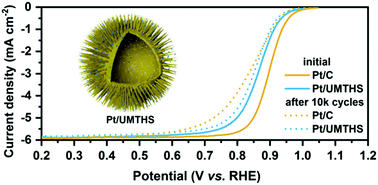Uniform Pt nanoparticles supported on urchin-like mesoporous TiO2 hollow spheres as stable electrocatalysts for the oxygen reduction reaction†
Abstract
In order to promote the commercial application of proton exchange membrane fuel cells, it is of great importance to develop Pt-based electrocatalysts with high activity and stability for the oxygen reduction reaction (ORR). Here, urchin-like mesoporous TiO2 hollow spheres (UMTHS) with a high specific surface area (167.1 m2 g−1) and improved conductivity were designed and applied as supports to disperse Pt nanoparticles (NPs) for the first time. Uniform Pt NPs (∼3.2 nm) on the surface of nanothorns were obtained after heat treatment. The as-prepared product (Pt/UMTHS) exhibited a more positive half-wave potential (Eh) than that of the reference sample Pt@C without UMTHS (0.867 V vs. 0.829 V). The improved performance can be ascribed to the high specific surface area of UMTHS. The Pt/UMTHS also exhibited a much better ORR stability than the commercial Pt/C after long-term cycling at 0.6–1.0 V according to the comparison of Eh, mass activity and electrochemical surface area with Pt/C. The enhanced stability of Pt/UMTHS was mainly derived from the strong metal support interaction between Pt NPs and UMTHS, together with the spatial restriction and the anti-restriction provided by UMTHS.

- This article is part of the themed collection: Celebrating 60 years of the Fujian Institute of Research on the Structure of Matter


 Please wait while we load your content...
Please wait while we load your content...